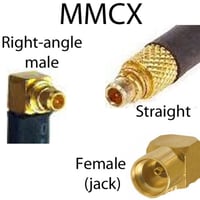N to MHF4 Cables
N-Type Connector to MHF4: Cables for Antennas
What is an MHF4 connector?
The MH4 connector is the smallest radio frequency connector in the world. It comprises a PCB-mounted male jack and female plug which mates with a press-down action.
When correctly mated, the mated height of the MHF4 connector is only 1.2mm (0.047 inches). The low profile of this connector makes it useful in a wide range of applications that require PCB connectivity in a component-dense environment.
Key physical characteristics of the MH4 connector
Male jack: The male MHF4 connector body is made from LCP-coated PBT with a gold plated ground contact. The center pin is made from silver or gold plated phosphor bronze.
Female plug: The female plug is made from a gold-plated copper alloy
The press-down mating action of the MH4 connector is rated for a maximum of 30 mating cycles. Lift the MHF4 connector plug vertically off the jack to prevent damage. Mate this connector by hand or using a special push-pull tool which prevents damage to the connector and surrounding components during mating.
Some versions of the MHF4 connector also have a locking feature to secure the mated connection and maintain the engagement force. It is also compatible with the Murata HSC MXHP32 connector, which has comparable dimensions.
Key electrical characteristics of the MH4 connector
- The MHF4 connector has a maximum frequency of 6 GHz.
- MHF4 connectors have a nominal impedance of 50 Ohms.
- The maximum voltage is 60 Volts.
- The VSWR of the MHF 4 connector is 1.3.
MH4 connector applications
The MHF4 connector is suitable for microwave applications and is often preferred to the U.FL as it provides a stronger connection / less signal loss when connected to antennas. They also connect securely to mini-PCI cards. Because the MHF4 connector is so small, it can be used with micro-coax in compact environments. This means that its use is widespread in a range of wireless devices including:
- Wi-Fi
- Bluetooth
- Cellular
- GPS
IoT devices and applications also use the MHF4 connector as device manufacturers can easily secrete it in sensors and actuators and, with low loss flexible micro coax, it delivers good signal performance.
Cable for the MHF4 connector
MHF4 pigtail adapters use high-quality, flexible micro coax to run from the PCB-mounted MHF4 connector to an externalized, usually larger connector. Most pigtail adapter uses 1.13 mm coax or similar. Here are the specifications of 1.13 mm coax:
- Overall diameter of 1.13mm (0.04 inches) / AWG of 32.
- Silver-plated annealed copper center conductor and non-polymer dielectric.
- Copper polyester tape as an insulating binder to enhance shielding.
- FEP jacket.
- Nominal impedance of 50 Ohms.
- Maximum frequency of between 6 and 8 GHz.
- low conductor resistance of 482Ohm/km.
- Insulation resistance of 3000 Ohm/km.
- VSWR is 1.3 between 0 and 6 GHz up to a maximum of 1.45 between 6 and 8GHz.
Type N connector
The size and ruggedness of an N-connector make it useful for outdoor applications, so radio devices that are primarily used or installed outdoors will use this connector. When used in a pigtail adapter with the MHF4 connector, it can be used to create a robust connection to a PCB that can withstand harsh environments and repeated mating. Here are the key specifications of the N connector:
Physical specifications of the N connector
- Threaded medium-size connector
- 5/8 - 24 pitched UNEF threading
- Mates by screw coupling; rated for 500+ mating cycles
- Material: nickel-plated brass or stainless steel
- Male N connector: diameter of 0.800 inches (20.3 millimeters) with internalized threads and hex nut
- Female N connector: diameter of 0.620 inches (15.7 millimeters)with externalized threads
- O-ring seal achieves an IP 67 rating, making the connection dust and moisture-free
- Standard N connectors do not have a dielectric
Electrical specifications of the N connector
- Nominal impedance: 50 ohms
- Maximum frequency: up to 11 GHz
- Peak voltage rating: 1500 volts
- Dielectric withstanding voltage: up to 2500 volts.
- VSWR of 1.3.
- Contact resistance: 1 milliohm
- Insertion loss: 0.15 dB.
- Radio frequency leakage: -90 decibels at 3GHz.







